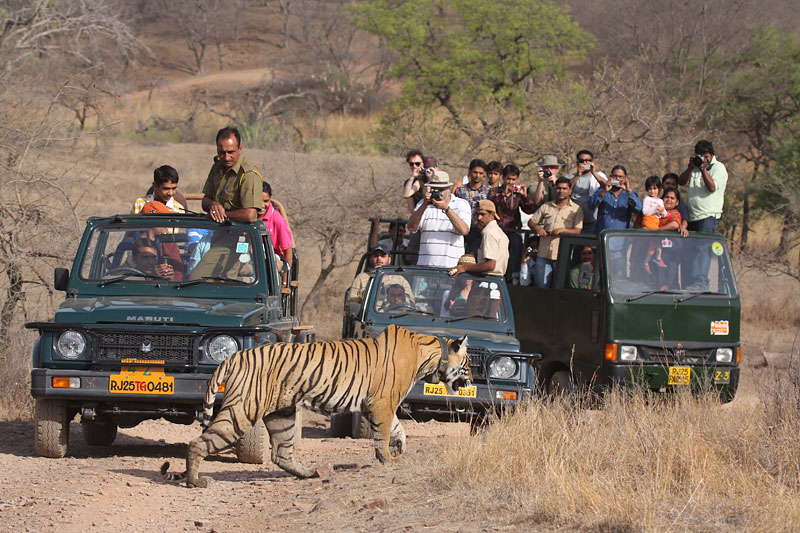By Julian Matthews
Chairman of TOFTigers
Email: [email protected]
It’s not really such a long time ago that I first visited Ranthambhore Tiger Reserve in Rajasthan. Infact it
was 1998, just 23 years ago. I checked into the one of only two small hotels, the Maharaja Man Singh’s old
hunting lodge on the bend of a tree lined road, not far from a small sleepy town, and backing onto the
reserve itself. I had heard there was a good chance of seeing a tiger here, the only place in the world where
this was a really possibility.
The place is unrecognisable today. A revolution has happened. Sawai Madhopur is a large bustling town that
has spread across the landscape and for miles down that tree lined road. This strip bordering the reserve is
now dotted with expensive resorts, lodgings and bed and breakfasts of every conceivable design and shape,
from the ubiquitous concrete monstrosities, to fake forts and mini palaces, complete with bulbous domes and
minarets, designed to attract the new moneyed Indian fraternity on their holidays and weekends away.
Whow – so is this good for tigers I hear you ask? Yes and no would be my answer.
Yes, because having declared in 2003 that the Royal Bengal Tiger was about to go extinct with only 11 left
in this area, India’s most famous park, now has over 70 wild cats. The park’s borders have expanded, many
locals have benefitted hugely with thousands of jobs and new livelihood opportunities in this once remote
marginal farming community. Great schools and hospitals have been built with visitor income. Furthermore
the park’s finances had never been better (before Covid!) from the 500,000 visitors each year, allowing
better protection, community support and compensation for livestock loss. Today the vast majority of
visitors are domestic – a sea change from when I visited in 1998 – all wishing to see their own natural
heritage – and this is the only surefire way to ensure nature conservation remains at the top of any
politician’s agenda in this fast developing nation.
No, because none of this was really planned. No thought was given to the key infrastructure needed for such
wholesale change, no town or park long term planning, no carry capacity thought through, no developmental
plans which allocate land to use – and land not to use – that may be injurious to the park and its wildlife. No
understanding as to aquifer drawn water needs and damage in this desert land, no thought on the incentives
and disincentives for poor buildings, poor operations or waste and other pollutants besides a world famous
park. Without this the real benefits of this new nature based tourism sector have probably failed to
materialise in the best, most judicious and just way for both wildlife and communities – and certainly not
sustainably.
It is unsustainable: This is not just me saying it – having predicted this 20 years ago when I first started
TOFTigers – but both UNWTO and Euromonitor Research put India at or near the bottom of the
sustainability global travel and tourism ranking. So what needs to happen to change this.
Here are my 6 key needs for a building back better strategy.
Recognise tourism
Recognise that tourism can be beneficial to destinations and communities, it can incentivize conservation
and support protection and enrich all our lives, economically, socially and culturally. Yet irresponsible and
unsustainable can do the exact opposite, so better planning and understanding of it is needed by Forest
departments, key ministries and the private sector.
Quantity to Quality
Manage tourism for the quality of the experience and its value to the host, the local
communities and nature. This required active/intensive destination management. Today this may even need
to contain or stop tourism’s land use.
With today’s social media great places and destinations highlight themselves – so federal and state tourism
boards need to move away from simple promotion and far more into destination management, alongside
park services, private sector, area authorities, civic society and panchayats.
Redefine success
This should no longer be on simple numbers of visitors, but favour customer satisfaction,
community development, small business development, job creation, fair income distribution as measures of
success. Set an early baseline and then monitor it. There is a need to ensure investment in destinations, it
will be net positive for communities and environment with monetary incentives and tax advantages.
Sustainable Standards: Set minimum standards of operations, using international standards like those of
Global Sustainable Tourism Council (GSTC) and Sustainable Tourism Criteria for India (STCI), incentivise and
encourage monitoring of these standards in destinations. Use taxes, awards, visitor benefits or special passes
to encourage and maintain best practice.
Collaboration/partnership
For the benefits of tourism to be materialised, it needs endless collaboration
and partnerships between all stakeholders – but it also needs good and judicious policies, regulations and
laws that both incentivise the encourage best practice – but also discourage and dis-incentivise the worst
practices.
Governments should not be the sole arbitrators of conservation and wildlife. It is critical to realise that
everyone can conserve nature, it should not just be a mandate for governments. We need to allow
communities to collaborate with private sector to protect, restore, reforest and conserve lands bordering or
connecting parks, around towns and cities or in rural areas too.
We have all become accustomed to the idea that tourism is a basic human right. It’s not – and if it was –
more than just one in five of the world population would be doing it. Travel and tourism are undoubted
privilege for a small part of society – and so it’s all travellers’ ultimate responsibility to demand that it’s
better, fairer and more sustainable, and they need to be prepared to pay for it. The pandemic may well have
highlighted this to an extent that we could never have done without it.
